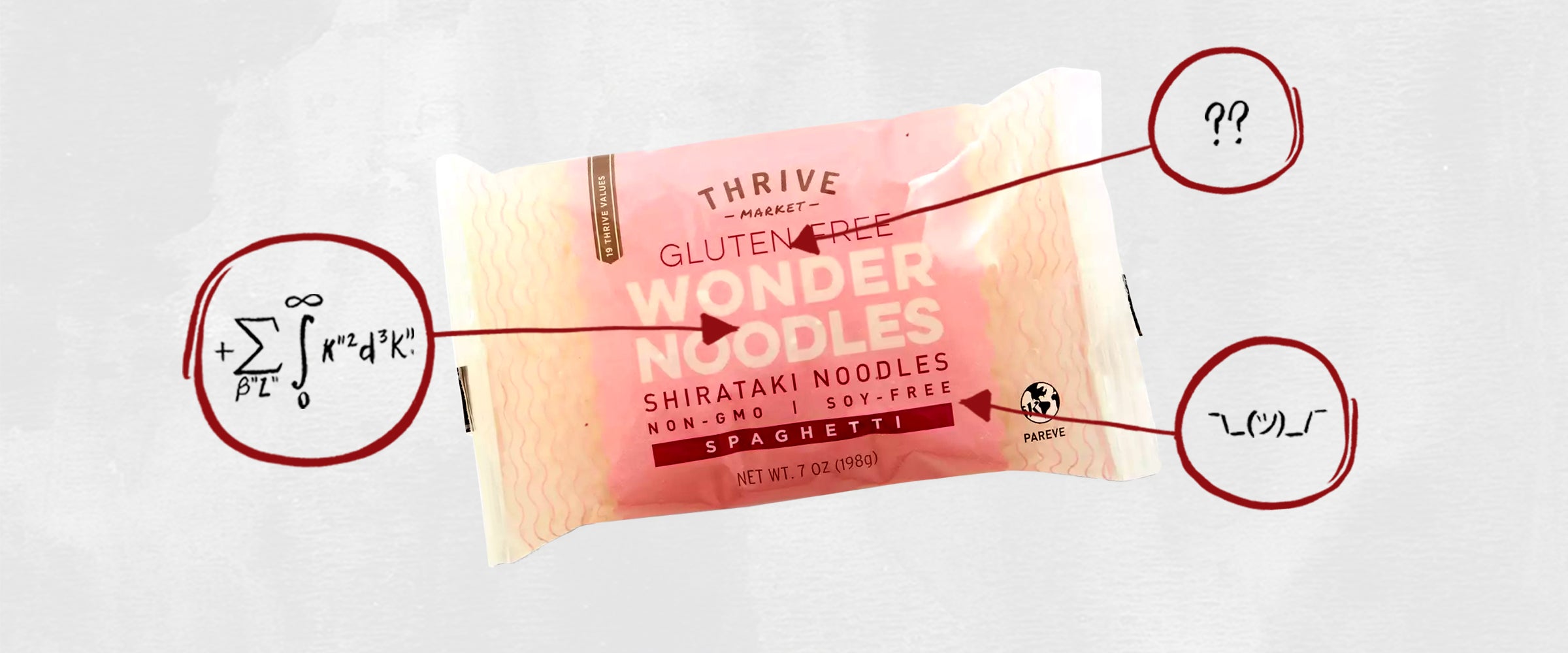We’re often told that you should never eat anything (or put anything on your body) if you don’t recognize everything on the ingredients list. But since most of us have no idea what xanthan gum or potassium benzoate are — or more importantly, what they’re doing to our bodies — we’re decoding the ingredients in the many things Americans put in (and on, or near) themselves.
This edition: Thrive Market Shirataki Noodles, which are made from three separate ingredients that I’ve broken down in the exact order they appear online.
But before delving into the ingredients, some background: Originating in Japan, shirataki is the Japanese word for white waterfall, which describes the thin, translucent and gelatinous appearance of these noodles. One of the more notable characteristics of shirataki noodles is that they boast virtually zero calories and no digestible carbs, hence their other name, “miracle noodles.” The ingredients, though, reveal the secrets behind these alleged edible miracles that pack no discernible weight (onto you at least).

The Ingredients
1) Purified Water: One of the biggest reasons shirataki noodles are so incredibly low in calories — they contain a measly 10 calories per serving — is because each one is composed of about 97 percent water. This also explains why these noodles are notably flavorless on their own.
2) Konjac Flour: This is the big boss ingredient in shirataki noodles. Also known as glucomannan flour, konjac flour comes from the root of the konjac plant, which is similar to a yam and grows in Japan, China and Southeast Asia. Once extracted from the plant, konjac flour is mixed with water — and sometimes limewater to help the noodles hold their shape — and turned into a gelatinous substance called konnyaku, which is finally shredded into individual shirataki noodles.
Glucomannan, the fiber extracted from the konjac plant, can absorb up to 50 times its weight in water, hence the high water content in these noodles. It also moves through the digestive tract at a relatively slow rate, which helps you feel full for longer. And since your body needs to use energy to ferment glucomannan, as it would with any kind of soluble fiber, studies show that the end result in eating a serving of shirataki noodles (which usually contain one to three grams of glucomannan) is a net total of hardly any calories.
Likewise, because glucomannan is fermented in the colon into gut-boosting short-chain fatty acids, you get those benefits too — i.e., enhanced mineral absorption, reduced inflammation, improved intestinal health and so on. Moreover, given that glucomannan moves through the stomach so slowly, eating shirataki noodles can help prevent unpleasant blood sugar spikes, which is especially nice for diabetics.
In other words, shirataki noodles are an awesome weight-loss tool, because they keep you full while consuming virtually no calories. And they might help your gut, too.
3) Calcium Hydroxide: This is that limewater I was talking about earlier. Again, it helps the noodles hold their shape, and it can make them a little more digestible.
The Takeaway
Frankly, these noods are pretty sweet, especially when you consider that the average noodles contains 200 calories per serving. The only problems with shirataki noodles is that they can be tricky to cook, and the liquid in the package can have a somewhat unpleasant odor, resulting in a slimy, stinky mess. Your best bet, as you can see in the video below, is to rinse them — which can help remove that nasty odor — and then pan-fry them to achieve a tougher, more noodle-like consistency.
Then just do what you normally do with noodles: Eat the entire bag, but this time, you can actually feel okay about doing so.

